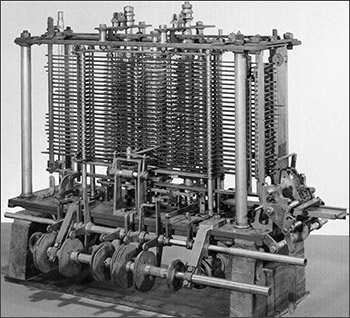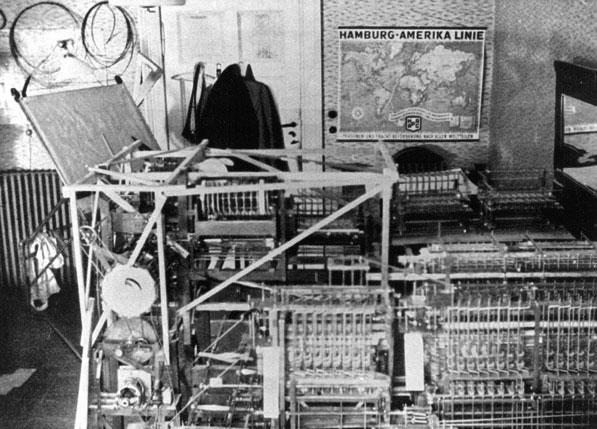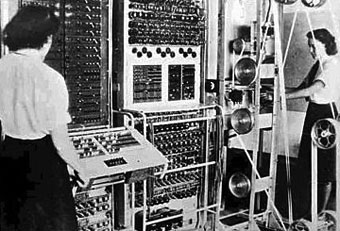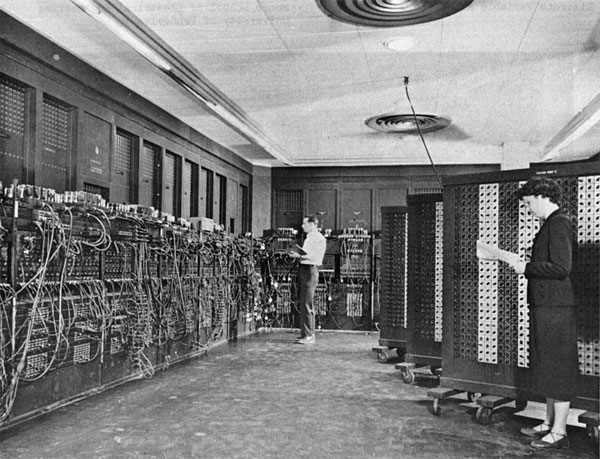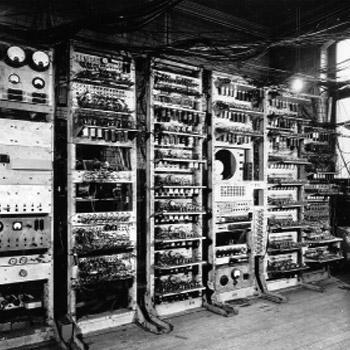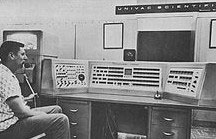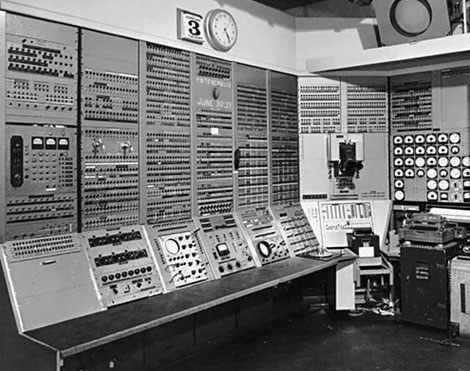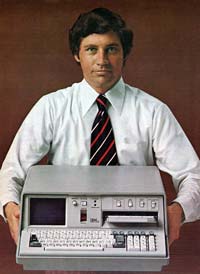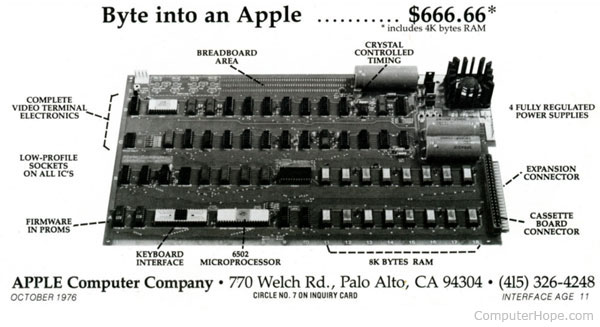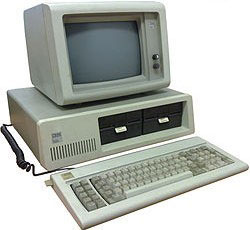How the first computer was developed
How the first computer was developed
When was the first computer invented?
There is no easy answer to this question due to the many different classifications of computers. The first mechanical computer, created by Charles Babbage in 1822, doesn’t resemble what most would consider a computer today. Therefore, this page provides a listing of each of the computer firsts, starting with the Difference Engine and leading up to the computers we use today.
Early inventions that lead up to the computer, such as the abacus, astrolabe, slide rule, clocks, calculator, and tablet machines, are not accounted for on this page.
When was the word «computer» first used?
The word «computer» was first used in 1613 in the book The Yong Mans Gleanings by Richard Braithwaite and originally described a human who performed calculations or computations. The definition of a computer remained the same until the end of the 19th century, when the industrial revolution gave rise to mechanical machines whose primary purpose was calculating.
First mechanical computer or automatic computing engine concept
In 1822, Charles Babbage conceptualized and began developing the Difference Engine, which is considered the first automatic computing machine that could approximate polynomials. The Difference Engine was capable of computing several sets of numbers and making hard copies of the results. Babbage received some help with the development of the Difference Engine from Ada Lovelace, considered to be the first computer programmer for her work. Unfortunately, because of funding, Babbage was never able to complete a full-scale functional version of this machine. In June 1991, the London Science Museum completed the Difference Engine No 2 for the bicentennial year of Babbage’s birth and later completed the printing mechanism in 2000.
First general-purpose computer
In 1837, Charles Babbage proposed the first general mechanical computer, the Analytical Engine. The Analytical Engine contained an ALU (Arithmetic Logic Unit), basic flow control, punch cards (inspired by the Jacquard Loom), and integrated memory. It is the first general-purpose computer concept that could be used for many things and not only one particular computation. Unfortunately, because of funding issues, this computer was also never built while Charles Babbage was alive. In 1910, Henry Babbage, Charles Babbage’s youngest son, was able to complete a portion of this machine and perform basic calculations.
The first machine to record and store information
In 1890, Herman Hollerith developed a method for machines to record and store information on punch cards for the US census. Hollerith’s machine was approximately ten times faster than manual tabulations and saved the census office millions of dollars. Hollerith would later form the company we know today as IBM.
First programmable computer
The Z1 was created by German Konrad Zuse in his parents’ living room between 1936 and 1938. It is considered to be the first electromechanical binary programmable computer and the first functional modern computer.
Konrad Zuse would also later created the Z3, the first functioning programmable computer that could be fully automated.
First concepts of what we consider a modern computer
The Turing machine was first proposed by Alan Turing in 1936 and became the foundation for theories about computing and computers. The machine was a device that printed symbols on paper tape in a manner that emulated a person following several logical instructions. Without these fundamentals, we wouldn’t have the computers we use today.
The first electric programmable computer
The Colossus was the first electric programmable computer, developed by Tommy Flowers, and was first demonstrated in December 1943. The Colossus was created to help the British code breakers read encrypted German messages.
The first digital computer
Short for Atanasoff-Berry Computer, the ABC began development by Professor John Vincent Atanasoff and graduate student Cliff Berry in 1937. Its development continued until 1942 at the Iowa State College (now Iowa State University).
The ABC was an electrical computer that used more than 300 vacuum tubes for digital computation, including binary math and Boolean logic, and had no CPU (was not programmable). On October 19, 1973, US Federal Judge Earl R. Larson signed his decision that the ENIAC patent by J. Presper Eckert and John Mauchly was invalid. In the decision, Larson named Atanasoff the sole inventor.
The ENIAC was invented by J. Presper Eckert and John Mauchly at the University of Pennsylvania and began construction in 1943 and was not completed until 1946. It occupied about 1,800 square feet and used about 18,000 vacuum tubes, weighing almost 50 tons. Although a judge later ruled the ABC computer was the first digital computer, many still consider the ENIAC to be the first digital computer because it was fully functional.
The first stored program computer
The first computer to electronically store and execute a program was the SSEM (Small-Scale Experimental Machine), also known as the «Baby» or «Manchester Baby,» in 1948. It was designed by Frederic Williams, and built by his protégée, Tom Kilburn, with the assistance of Geoff Tootill, at the University of Manchester, England. Kilburn wrote the first electronically-stored program, which finds the highest proper factor of an integer, using repeated subtraction rather than division. Kilburn’s program was executed on June 21, 1948.
The second stored-program computer was also British: the EDSAC, built and designed by Maurice Wilkes at the University of Cambridge Mathematical Laboratory in England. The EDSAC performed its first calculation on May 6, 1949. It was also the first computer to run a graphical computer game, «OXO,» an implementation of tic-tac-toe displayed on a 6-inch cathode ray tube.
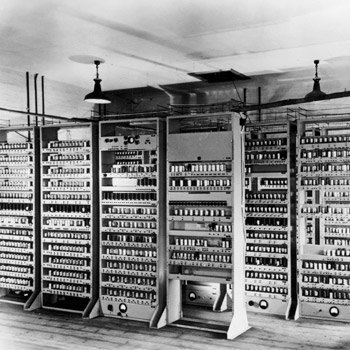
Around the same time, the Manchester Mark 1 was another computer that could run stored programs. Built at the Victoria University of Manchester, the first version of the Mark 1 computer became operational in April 1949. Mark 1 was used to run a program to search for Mersenne primes for nine hours without error on June 16 and 17 that same year.
The first computer company
The first computer company was Electronic Controls Company and was founded in 1949 by J. Presper Eckert and John Mauchly, the same individuals who helped create the ENIAC computer. The company was later renamed to EMCC or Eckert-Mauchly Computer Corporation and released several mainframe computers under the UNIVAC name.
First computer with a program stored in memory
First delivered to the United States government in 1950, the UNIVAC 1101 or ERA 1101 is considered the first computer capable of storing and running a program from memory.
First commercial computer
In 1942, Konrad Zuse began working on the Z4 that later became the first commercial computer. The computer was sold to Eduard Stiefel, a mathematician of the Swiss Federal Institute of Technology Zurich, on July 12, 1950.
IBM’s first computer
On April 7, 1953, IBM publicly introduced the 701, its first commercial scientific computer.
The first computer with RAM
MIT introduces the Whirlwind machine on March 8, 1955, a revolutionary computer that was the first digital computer with magnetic core RAM and real-time graphics.
The first transistor computer
The TX-0 (Transistorized Experimental computer) is the first transistorized computer to be demonstrated at the Massachusetts Institute of Technology in 1956.
The first minicomputer
In 1960, Digital Equipment Corporation released its first of many PDP computers, the PDP-1.
The first desktop and mass-market computer
In 1968, Hewlett Packard began marketing the HP 9100A, considered to be the first mass-marketed desktop computer.
The first workstation
Although it was never sold, the first workstation is considered to be the Xerox Alto, introduced in 1974. The computer was revolutionary for its time and included a fully functional computer, display, and mouse. The computer operated like many computers today utilizing windows, menus, and icons as an interface to its operating system. Many of the computer’s capabilities were first demonstrated in The Mother of All Demos by Douglas Engelbart on December 9, 1968.
The first microprocessor
Intel introduces the first microprocessor, the Intel 4004, on November 15, 1971.
The first microcomputer
The first personal computer (PC)
The first laptop or portable computer
The IBM 5100 is the first portable computer, which was released in September 1975. The computer weighed 55-pounds and had a five-inch CRT display, tape drive, 1.9 MHz PALM processor, and 64 KB of RAM. In the picture is an ad of the IBM 5100 taken from a November 1975 issue of Scientific American.
The IBM PCD (PC Division) later released the IBM portable in 1984, its first portable computer that weighed 30-pounds. Later in 1986, IBM PCD announced its first laptop computer, the PC Convertible, weighing 12-pounds. Finally, in 1994, IBM introduced the IBM ThinkPad 775CD, the first notebook with an integrated CD-ROM.
The first Apple computer
The first IBM personal computer
IBM introduced its first personal computer, the IBM PC, in 1981. The computer was code-named Acorn. It featured an 8088 processor, 16 KB of memory, which was expandable to 256 and used MS-DOS.
The first PC clone
The Compaq Portable is considered to be the first PC clone and was released in March 1983 by Compaq. The Compaq Portable was 100% compatible with IBM computers and was capable of running any software developed for IBM computers.
The first multimedia computer
In 1992, Tandy Radio Shack released the M2500 XL/2 and M4020 SX, among the first computers to feature the MPC standard.
Other computer company firsts
Below is a listing of some of the computer company’s first computers.
oren-english.ru
How the First Computer Was Developed
The first suggestion that the machine for mathematical computation could be built was made more than a hundred years ago by the mathematician Charles Babbage. We now realize that he understood clearly all the fundamental principles of modern computers.
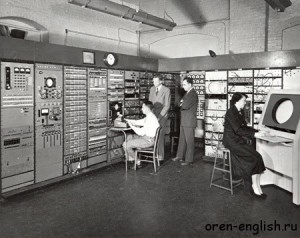
At that time mathematics in Cambridge was still under the influence of Newton and quite unaffected by the contemporary developments on the continent.
Charles Babbage was outstanding among his contemporaries because he insisted on the practical application of science and mathematics. For example, he wrote widely on the economic advantages of machine tools.
In 1812 he was sitting in his room looking at a table of logarithms which he knew to be full of mistakes, when an idea occurred to him of computing all tabular function by machinery. Babbage constructed a small working model which he demonstrated in 1822.
The Royal Society supported the project, and Babbage was promised a subsidy.
In 1833 he began to think of building a machine which was in fact the first universal digital computer, as the expression is understood today.
Babbage devoted the rest of his life to an attempt to develop it. He had to finance all of the work himself and he was only able to finish part of the machine though he prepared thousands of detailed drawings from which it could be made.
Babbage wrote more than 80 books and papers, but he was misunderstood by his contemporaries and died a disappointed man in 1871.
He tried to solve by himself and with his own resources a series of problems which in the end required the united efforts of two generations of engineers.
After his death his son continued his work and built part of an arithmetic unit, which printed out its results directly on paper.

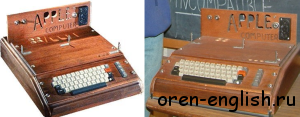

As 8-bit CPU machines became widely accepted, the number of portables increased rapidly. 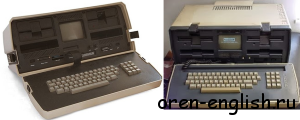

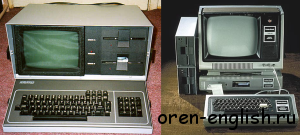
Who Invented the Computer?
By: William Harris | Updated: Apr 12, 2021
We could argue that the first computer was the abacus or its descendant, the slide rule, invented by William Oughtred in 1622. But the first computer resembling today’s modern machines was the Analytical Engine, a device conceived and designed by British mathematician Charles Babbage between 1833 and 1871. Before Babbage came along, a «computer» was a person, someone who literally sat around all day, adding and subtracting numbers and entering the results into tables. The tables then appeared in books, so other people could use them to complete tasks, such as launching artillery shells accurately or calculating taxes.
It was, in fact, a mammoth number-crunching project that inspired Babbage in the first place [source: Campbell-Kelly]. Napoleon Bonaparte initiated the project in 1790, when he ordered a switch from the old imperial system of measurements to the new metric system. For 10 years, scores of human computers made the necessary conversions and completed the tables. Bonaparte was never able to publish the tables, however, and they sat collecting dust in the Académie des sciences in Paris.
In 1819, Babbage visited the City of Light and viewed the unpublished manuscript with page after page of tables. If only, he wondered, there was a way to produce such tables faster, with less manpower and fewer mistakes. He thought of the many marvels generated by the Industrial Revolution. If creative and hardworking inventors could develop the cotton gin and the steam locomotive, then why not a machine to make calculations [source: Campbell-Kelly]?
Babbage returned to England and decided to build just such a machine. His first vision was something he dubbed the Difference Engine, which worked on the principle of finite differences, or making complex mathematical calculations by repeated addition without using multiplication or division. He secured government funding in 1824 and spent eight years perfecting his idea. In 1832, he produced a functioning prototype of his table-making machine, only to find his funding had run out.
But, as you might have guessed, the story doesn’t end there.
Charles Babbage and the Analytical Engine
Unfortunately, the technology of the day couldn’t deliver on Babbage’s ambitious design. It wasn’t until 1991 that his particular ideas were finally translated into a functioning computer. That’s when the Science Museum in London built, to Babbage’s exact specifications, his Difference Engine. It stands 11 feet long and 7 feet tall (more than 3 meters long and 2 meters tall), contains 8,000 moving parts and weighs 15 tons (13.6 metric tons). A copy of the machine was built and shipped to the Computer History Museum in Mountain View, Calif., where it remained on display until December 2010. Neither device would function on a desktop, but they are no doubt the first computers and precursors to the modern PC. And those computers influenced the development of the World Wide Web.
If Charles Babbage was the genius behind the Analytic Engine, then Augusta Ada Byron, or Ada Lovelace, was the publicist (and, arguably, the very first computer programmer). She met Babbage at a party when she was 17 and became fascinated by the mathematician’s computer engine. From that chance meeting grew a strong, dynamic relationship. Ada discussed Babbage’s ideas with him and, because she was gifted in mathematics, offered her own insights. In 1843, she published an influential set of notes describing Babbage’s Analytical Engine. Ada also added in some sage predictions, speculating that Babbage’s mechanical computers might one day «act upon other things besides numbers» and «compose elaborate and scientific pieces of music of any degree of complexity …»
The first computer
By the second decade of the 19th century, a number of ideas necessary for the invention of the computer were in the air. First, the potential benefits to science and industry of being able to automate routine calculations were appreciated, as they had not been a century earlier. Specific methods to make automated calculation more practical, such as doing multiplication by adding logarithms or by repeating addition, had been invented, and experience with both analog and digital devices had shown some of the benefits of each approach. The Jacquard loom (as described in the previous section, Computer precursors) had shown the benefits of directing a multipurpose device through coded instructions, and it had demonstrated how punched cards could be used to modify those instructions quickly and flexibly. It was a mathematical genius in England who began to put all these pieces together.
The Difference Engine
Charles Babbage was an English mathematician and inventor: he invented the cowcatcher, reformed the British postal system, and was a pioneer in the fields of operations research and actuarial science. It was Babbage who first suggested that the weather of years past could be read from tree rings. He also had a lifelong fascination with keys, ciphers, and mechanical dolls.
As a founding member of the Royal Astronomical Society, Babbage had seen a clear need to design and build a mechanical device that could automate long, tedious astronomical calculations. He began by writing a letter in 1822 to Sir Humphry Davy, president of the Royal Society, about the possibility of automating the construction of mathematical tables—specifically, logarithm tables for use in navigation. He then wrote a paper, “ On the Theoretical Principles of the Machinery for Calculating Tables,” which he read to the society later that year. (It won the Royal Society’s first Gold Medal in 1823.) Tables then in use often contained errors, which could be a life-and-death matter for sailors at sea, and Babbage argued that, by automating the production of the tables, he could assure their accuracy. Having gained support in the society for his Difference Engine, as he called it, Babbage next turned to the British government to fund development, obtaining one of the world’s first government grants for research and technological development.
Babbage approached the project very seriously: he hired a master machinist, set up a fireproof workshop, and built a dustproof environment for testing the device. Up until then calculations were rarely carried out to more than 6 digits; Babbage planned to produce 20- or 30-digit results routinely. The Difference Engine was a digital device: it operated on discrete digits rather than smooth quantities, and the digits were decimal (0–9), represented by positions on toothed wheels, rather than the binary digits that Leibniz favoured (but did not use). When one of the toothed wheels turned from 9 to 0, it caused the next wheel to advance one position, carrying the digit just as Leibniz’s Step Reckoner calculator had operated.
The Difference Engine was more than a simple calculator, however. It mechanized not just a single calculation but a whole series of calculations on a number of variables to solve a complex problem. It went far beyond calculators in other ways as well. Like modern computers, the Difference Engine had storage—that is, a place where data could be held temporarily for later processing—and it was designed to stamp its output into soft metal, which could later be used to produce a printing plate.
Nevertheless, the Difference Engine performed only one operation. The operator would set up all of its data registers with the original data, and then the single operation would be repeatedly applied to all of the registers, ultimately producing a solution. Still, in complexity and audacity of design, it dwarfed any calculating device then in existence.
The full engine, designed to be room-size, was never built, at least not by Babbage. Although he sporadically received several government grants—governments changed, funding often ran out, and he had to personally bear some of the financial costs—he was working at or near the tolerances of the construction methods of the day, and he ran into numerous construction difficulties. All design and construction ceased in 1833, when Joseph Clement, the machinist responsible for actually building the machine, refused to continue unless he was prepaid. (The completed portion of the Difference Engine is on permanent exhibition at the Science Museum in London.)
The Analytical Engine
While working on the Difference Engine, Babbage began to imagine ways to improve it. Chiefly he thought about generalizing its operation so that it could perform other kinds of calculations. By the time the funding had run out in 1833, he had conceived of something far more revolutionary: a general-purpose computing machine called the Analytical Engine.
The Analytical Engine was to be a general-purpose, fully program-controlled, automatic mechanical digital computer. It would be able to perform any calculation set before it. Before Babbage there is no evidence that anyone had ever conceived of such a device, let alone attempted to build one. The machine was designed to consist of four components: the mill, the store, the reader, and the printer. These components are the essential components of every computer today. The mill was the calculating unit, analogous to the central processing unit (CPU) in a modern computer; the store was where data were held prior to processing, exactly analogous to memory and storage in today’s computers; and the reader and printer were the input and output devices.
As with the Difference Engine, the project was far more complex than anything theretofore built. The store was to be large enough to hold 1,000 50-digit numbers; this was larger than the storage capacity of any computer built before 1960. The machine was to be steam-driven and run by one attendant. The printing capability was also ambitious, as it had been for the Difference Engine: Babbage wanted to automate the process as much as possible, right up to producing printed tables of numbers.
The reader was another new feature of the Analytical Engine. Data (numbers) were to be entered on punched cards, using the card-reading technology of the Jacquard loom. Instructions were also to be entered on cards, another idea taken directly from Jacquard. The use of instruction cards would make it a programmable device and far more flexible than any machine then in existence. Another element of programmability was to be its ability to execute instructions in other than sequential order. It was to have a kind of decision-making ability in its conditional control transfer, also known as conditional branching, whereby it would be able to jump to a different instruction depending on the value of some data. This extremely powerful feature was missing in many of the early computers of the 20th century.
By most definitions, the Analytical Engine was a real computer as understood today—or would have been, had not Babbage run into implementation problems again. Actually building his ambitious design was judged infeasible given the current technology, and Babbage’s failure to generate the promised mathematical tables with his Difference Engine had dampened enthusiasm for further government funding. Indeed, it was apparent to the British government that Babbage was more interested in innovation than in constructing tables.
All the same, Babbage’s Analytical Engine was something new under the sun. Its most revolutionary feature was the ability to change its operation by changing the instructions on punched cards. Until this breakthrough, all the mechanical aids to calculation were merely calculators or, like the Difference Engine, glorified calculators. The Analytical Engine, although not actually completed, was the first machine that deserved to be called a computer.
Lady Lovelace, the first programmer
The distinction between calculator and computer, although clear to Babbage, was not apparent to most people in the early 19th century, even to the intellectually adventuresome visitors at Babbage’s soirees—with the exception of a young girl of unusual parentage and education.
Augusta Ada King, the countess of Lovelace, was the daughter of the poet Lord Byron and the mathematically inclined Anne Millbanke. One of her tutors was Augustus De Morgan, a famous mathematician and logician. Because Byron was involved in a notorious scandal at the time of her birth, Ada’s mother encouraged her mathematical and scientific interests, hoping to suppress any inclination to wildness she may have inherited from her father.
Toward that end, Lady Lovelace attended Babbage’s soirees and became fascinated with his Difference Engine. She also corresponded with him, asking pointed questions. It was his plan for the Analytical Engine that truly fired her imagination, however. In 1843, at age 27, she had come to understand it well enough to publish the definitive paper explaining the device and drawing the crucial distinction between this new thing and existing calculators. The Analytical Engine, she argued, went beyond the bounds of arithmetic. Because it operated on general symbols rather than on numbers, it established “a link…between the operations of matter and the abstract mental processes of the most abstract branch of mathematical science.” It was a physical device that was capable of operating in the realm of abstract thought.
Lady Lovelace rightly reported that this was not only something no one had built, it was something that no one before had even conceived. She went on to become the world’s only expert on the process of sequencing instructions on the punched cards that the Analytical Engine used; that is, she became the world’s first computer programmer.
One feature of the Analytical Engine was its ability to place numbers and instructions temporarily in its store and return them to its mill for processing at an appropriate time. This was accomplished by the proper sequencing of instructions and data in its reader, and the ability to reorder instructions and data gave the machine a flexibility and power that was hard to grasp. The first electronic digital computers of a century later lacked this ability. It was remarkable that a young scholar realized its importance in 1840, and it would be 100 years before anyone would understand it so well again. In the intervening century, attention would be diverted to the calculator and other business machines.
HOW WAS THE FIRST COMPUTER DEVELOPED?
The first suggestion that a machine for mathematical computation could be built was made more than a hundred years ago by the mathematician Charles Babbage. Now we realize that he understood clearly all the fundamental principles of modern digital computers.
Babbage was born in Devonshire, England, in 1792. He did not receive good education but he himself taught mathematics so well that when he went to Cambridge he found that he knew more algebra than his tutor.
At that time mathematics in Cambridge was still under the influence of Newton and was quite unaffected by the contemporary developments on the Continent.
Babbage was an outstanding personality among his contemporaries because he insisted on the practical application of science and mathematics. For example, he wrote on the economic advantages of mass production, and on the development of machine-tools.
In 1812 he was sitting in his room looking at a logarithm table which he knew to be full of mistakes when the idea of computing all tabular functions by machinery occurred to him. Babbage constructed a small working model which he demonstrated in 1822. The Royal Society supported the project and Babbage was promised a subsidy.
In 1833 he began to think of building a machine which was, in fact, the first universal digital computer, as it is understood today. Babbage devoted the rest of his life to an attempt to develop it. He had to finance the work himself and he was only able to finish part of the machine though he prepared thousands of detailed drawings from which it could be made.
Babbage wrote more than 80 books and papers, but he was misunderstood by his contemporaries and died a disappointed man in 1871. He tried to solve by himself and with his own resources a series of problems which required the united efforts of two generations of engineers.
After his death his son continued his work and built the part of an arithmetic unit which printed out its results directly on paper.
XV. Дайте русские эквиваленты следующих словосочетаний и фраз.
the fundamental principles of a computer; to receive education; to be under the influence of; to be unaffected by; contemporary developments in science; to insist upon the application of mathematics; to write a paper on a problem; an idea occurred to him; to support a project; to devote efforts to; the rest of his life; to solve a series of problems; to build an arithmetic unit from drawings.
XVI. Найдите в тексте английские эквиваленты следующих словосочетаний:
объединенные усилия, первое предположение, экономические преимущества массового производства, тысячи подробных чертежей, разочарованный человек.
XVII. Сгруппируйте следующие слова и словосочетания в синонимичные пары и переведите их.
 1 basic laws 2. to be dominated by 3. prominent 4. to show; 5. to back 6. to give much time 7. to be not understood 1 basic laws 2. to be dominated by 3. prominent 4. to show; 5. to back 6. to give much time 7. to be not understood | a. to devote much time b. to demonstrate c. to be misunderstood d. to support e. fundamental principles f. outstanding g. to be under the influence of |
XVIII. Перефразируйте следующие предложения, используя предыдущее упражнение. Предложения переведите.
1) Не understood all the basic laws of modern digital computers.
2) At that time mathematics in Cambridge was dominated by Newton.
3) Babbage was a prominent man among his contemporaries.
4) He showed a working model of his machine in 1822.
5) The Royal Society backed his project.
6) He gave much time to the development of his machine.
7) Babbage was not understood by his contemporaries.
XIX. Преобразуйте следующие предложения в соответствии с моделью.
Model: We use computers in research. Computers are used in research.
1) The Royal Society promised him a subsidy.
2) The contemporary developments on the Continent did not affect mathematics in Cambridge.
3) The Royal Society supported his project.
4) He did not finish the machine.
5) He constructed а small working model of a computing machine.
6) He demonstrated it in 1822.
7) His son continued his work.
XX. Подтвердите или опровергните следующие высказывания, используя речевые модели.
| Для подтверждения: I quite agree with you. You’re quite right. That’s right. | Для опровержения: I don’t think so. I don’t think you are right. I’m afraid, you’re mistaken. |
1) The idea of a computing machine was first suggested 50 years ago.
2) At that time mathematics in Cambridge was unaffected by the contemporary
developments on the Continent.
3) Babbage was a pure mathematician, he was against the practical application
of mathematics.
4) Babbage constructed a working model of the first universal digital computer.
5) He was given a large sum of money to complete his work.
6) He prepared many drawings from which the machine could be made.
7) Charles Babbage’s life was a success and he died a happy man.
8) The arithmetic unit constructed by his son could print out its results directly
on paper.
Дата добавления: 2015-09-15 ; просмотров: 15 ; Нарушение авторских прав
